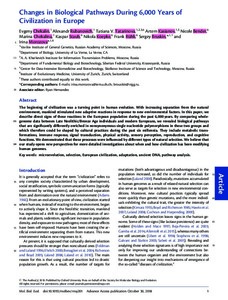Changes in Biological Pathways During 6,000 Years of Civilization in Europe
Скачать файл:
Автор:
Evgeny, Chekalin
Alexandr, Rubanovich
Tatiana, V Tatarinova
Artem, Kasianov
Nicole, Bender
Коллективный автор:
Институт фундаментальной биологии и биотехнологии
Базовая кафедра защиты и современных технологии мониторинга лесов
Дата:
2019-01Журнал:
Molecular Biology and EvolutionКвартиль журнала в Scopus:
Q1Квартиль журнала в Web of Science:
Q1Библиографическое описание:
Evgeny, Chekalin. Changes in Biological Pathways During 6,000 Years of Civilization in Europe [Текст] / Chekalin Evgeny, Rubanovich Alexandr, V Tatarinova Tatiana, Kasianov Artem, Bender Nicole // Molecular Biology and Evolution. — 2019. — Т. 36 (№ 1). — С. 127-140Аннотация:
The beginning of civilization was a turning point in human evolution. With increasing separation from the natural environment, mankind stimulated new adaptive reactions in response to new environmental factors. In this paper, we describe direct signs of these reactions in the European population during the past 6,000 years. By comparing whole-genome data between Late Neolithic/Bronze Age individuals and modern Europeans, we revealed biological pathways that are significantly differently enriched in nonsynonymous single nucleotide polymorphisms in these two groups and which therefore could be shaped by cultural practices during the past six millennia. They include metabolic transformations, immune response, signal transduction, physical activity, sensory perception, reproduction, and cognitive functions. We demonstrated that these processes were influenced by different types of natural selection. We believe that our study opens new perspectives for more detailed investigations about when and how civilization has been modifying human genomes.

